by Editor | Oct 24, 2016 | Attractions, Luxury Travel
By Elena del Valle
Photos by Gary Cox
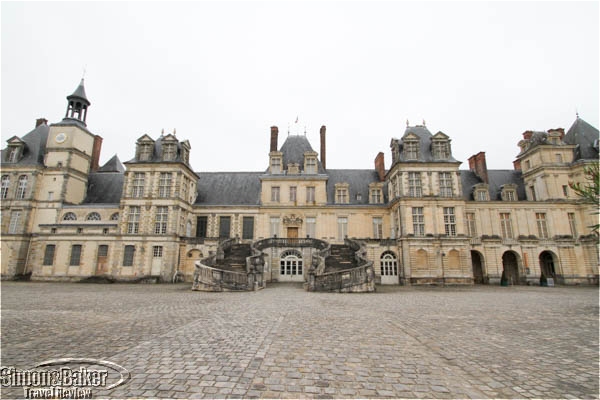
Fontainebleau Castle from the gate
During a spring trip to Paris, France we visited the nearby town of Fontainebleau, in the Seine-et-Marne Department (www.turisme77.co.uk and www.paris-whatelse.com), known for its former royal residence and forest. There was too much to see in one day so we spent the night at La Demeure du Parc, a boutique hotel established in late 2015 that was conveniently located within easy walking distance from Fontainebleau Castle.

During our tour we walked past one of the water fountains named for Diana
Since our time was short and it was our first visit to the area we took advantage of the opportunity of a guided tour in English. We met Véronique Villalba (v.villalba@laposte.net), our licensed guide, at 10 a.m. in front of the castle for Les Grands Appartements Tour, a private two-hour visit of Fontainebleau. A graduate of the University of Nanterre specializing in art history she had 10 years of experience as a guide. It was her friendly demeanor and passion for history that brought the former castle stories to life and made our morning activity memorable.
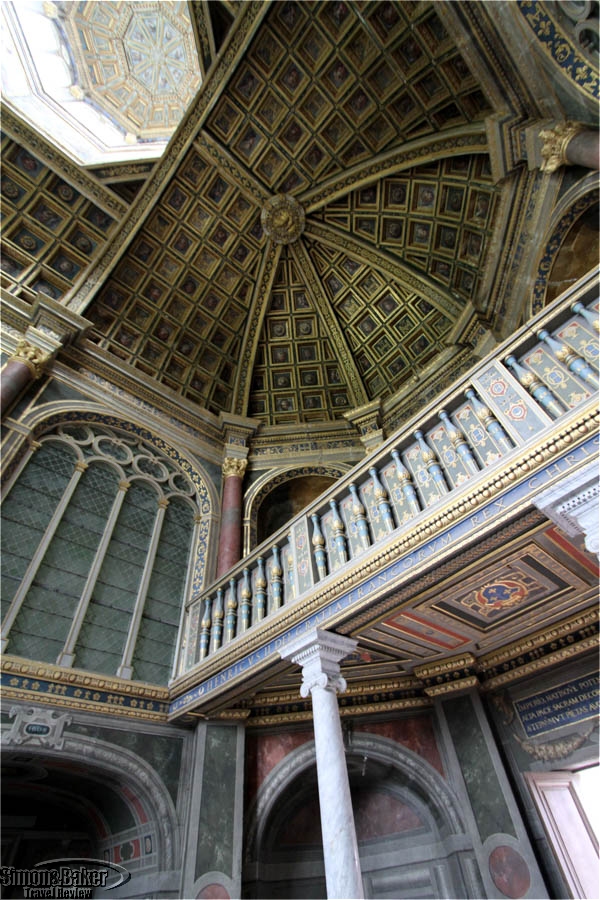
The interior design varied according to the time period of construction.
When I asked her why the historic attraction was special she explained that it was the sole castle that housed French kings for more than eight centuries (taking into account an interruption due to the Hundred Years’ War). In contrast, she explained, Versailles only served that purpose for four centuries and the Louvre had only become a royal home 650 years earlier.
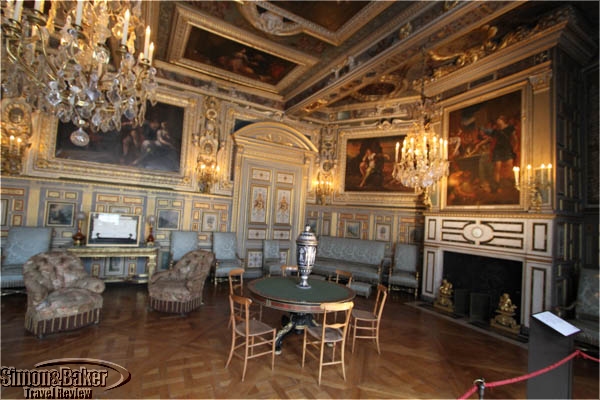
One of the characteristics worth noting was that the castle retained period furniture
Fontainebleau Castle, established circa 1137, was large. The fortified complex occupied 46,500 square meters of space in 13 floors, which included 1,536 rooms. Of those, 6,000 square meters were open to the public. It had 130 hectares of parks and gardens with 42,500 plants, and employed 135 staff. Despite the chilly and rainy weather we encountered it was by no means devoid of visitors. On the plus side, with only 470,000 visitors in 2015 it was a much more serene attraction than the Louvre or Versailles, both of which had millions of visitors a year each.
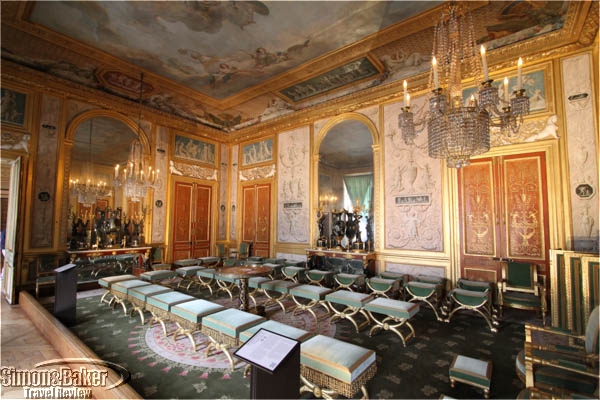
The Grand Salon de l’Imperatrice
The attraction itself was made up of a hodgepodge of buildings, improved and modified on the whims and budget strings of its powerful owners over the years. Despite our brief visit we toured interior and exterior areas. That the interior rooms were frequently furnished with original pieces, she explained, lent the castle a notable ambiance absent in other castles and palaces where the furniture and art had been sold years earlier.
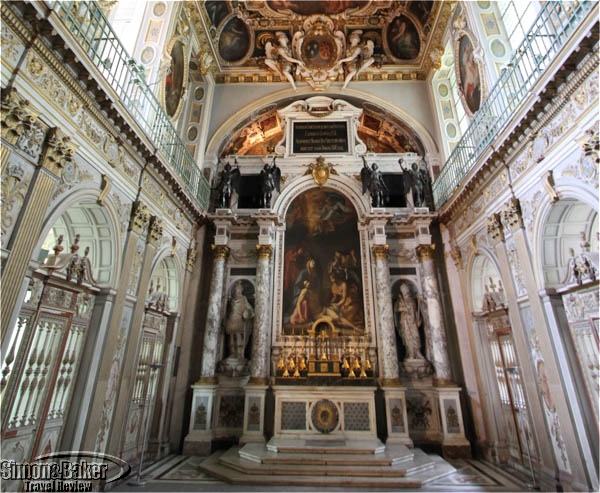
The Chapelle de la Trinité
We visited the Royal apartments, Renaissance Rooms, one of Marie Antoinette’s Boudoirs, Francis I Gallery, Galerie de Diane, Chapel of the Trinity, Chapelle basse Saint-Saturnin (only the upper level). We saw many of the masterpieces: The Duke of Orléans Commemorative Wedding Cabinet, Charlemagne in the Guise of Henry IV (in the Chapelle de la Trinité), The Royal Elephant (in the Galerie François Ier), Alexander Taming Bucephalus (in the Galerie François Ier), Odyssey Cabinet (in the Ancienne Chambre de la Reine), Beneman Commode (in la Nouvelle Chambre de la Reine), Marie Antoinette’s Bed, Napoleon’s Throne. Outside we walked through or caught a glimpse of its gardens and courtyards (sometimes from a distance): Cour Ovale, Cour de la Fontaine Cour d’Honneur, Cour des Offices, Grand Parterre (created by André Le Nôtre and Louis Le Vau and said to be Louis XIV’s greatest architectural achievement at Fontainebleau), Jardin Anglais, Jardin de Diane, Grotte des Pins, Pavillion de l’Étang, and Park. Should I return to Fontainebleau I would enjoy another visit to the castle, especially in the company of Véronique Villalba, for further discovery and leisurely exploration, including time in its gardens if the weather is clear.
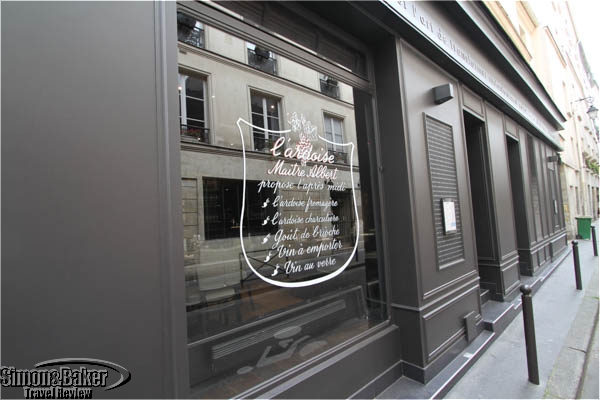
by Editor | Oct 10, 2016 | Restaurants
By Elena del Valle
Photos by Gary Cox
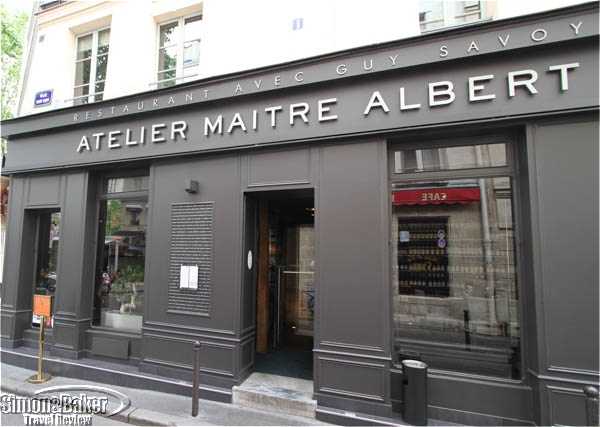
The front of Atelier Maitre Albert Restaurant avec Guy Savoy
Despite its reputation as a culinary capital Paris, France is one of those cities where picking a restaurant at random may result in a memorable find or a disaster, and the price difference might be negligible. The more touristy the area the greater the chances of disappointment, so as a general rule I make a point of not going to unfamiliar restaurants in zones popular among visitors, especially in the vicinity of tourist magnets such as the Latin Quarter, Le Marais, Arc de Triomphe, Champs Elysees, and Eiffel Tower, for example.
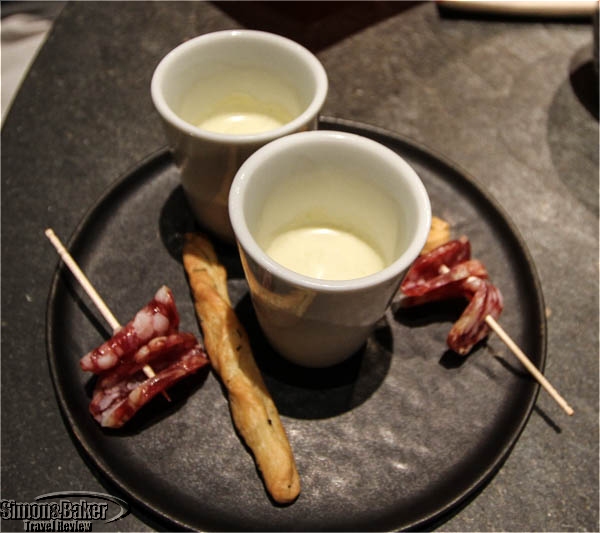
Our light bites as amouse bouche
One way to reduce the chances of a less than stellar expensive meal is to sample restaurants owned by or part of the portfolio of a well known chef. This has been particularly true when I have sampled the cuisine at one of the restaurants already. Such was the case of the Atelier Maître Albert
(1, rue Maître Albert, 75005 Paris, France, + 33 1 56 81 30 01, fax +33 1 53 10 83 23, www.ateliermaitrealbert.com, ateliermaitrealbert@guysavoy.com), part of the Guy Savoy food constellation. Prior to going there I had dined at Guy Savoy’s eponymous gourmet restaurant as well as Les Bouquinistes (see Latin Quarter restaurant nice neighborhood option) and Le Chiberta (see Le Chiberta, a restaurant find near the Champs Elysees), and had sampled the products of his new bakery outlet specializing in brioche. Most of those experiences had been rewarding so I was confident my meal at the Atelier Maitre Albert would also be worthwhile.
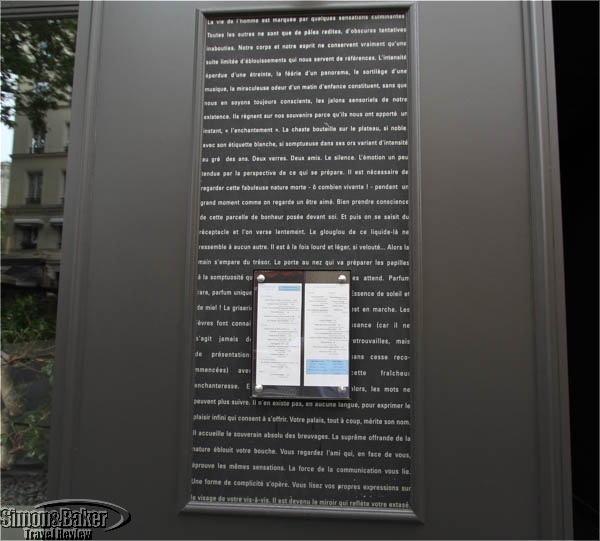
The menu was posted outside
Located at the beginning of a narrow street in the Left Bank across the Seine River from the famous Notre Dame Cathedral the restaurant was a pleasant surprise because while I had walked the neighborhood countless times I had no idea the restaurant was on that street, a 10 minute walk from my central accommodations. Except for the famed chef’s name on the exterior wall, the modern facade revealed little of the restaurant’s ambiance or its high quality comfort food.
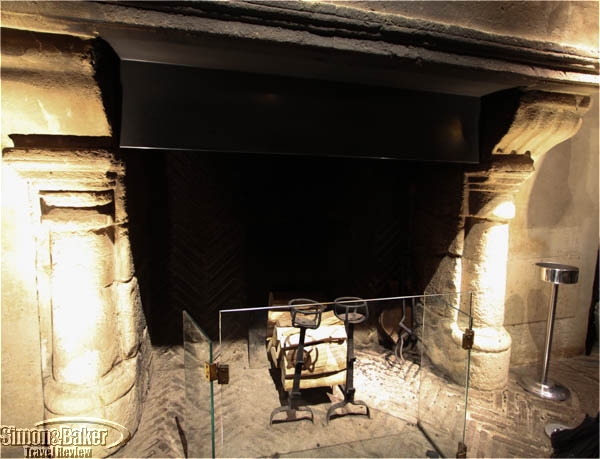
Our seats were next to a large fireplace
As soon as we entered a young man with hip bleached blond hair welcomed us warmly. Moments later, after handing over our rain gear, we were seated in armless chairs next to the unlit fireplace in the restaurant’s ground floor dining room. From our seats we had a generous view of the entire dining area and across to the open kitchen and its grills. There was also window side dining near the entrance with views of the street.
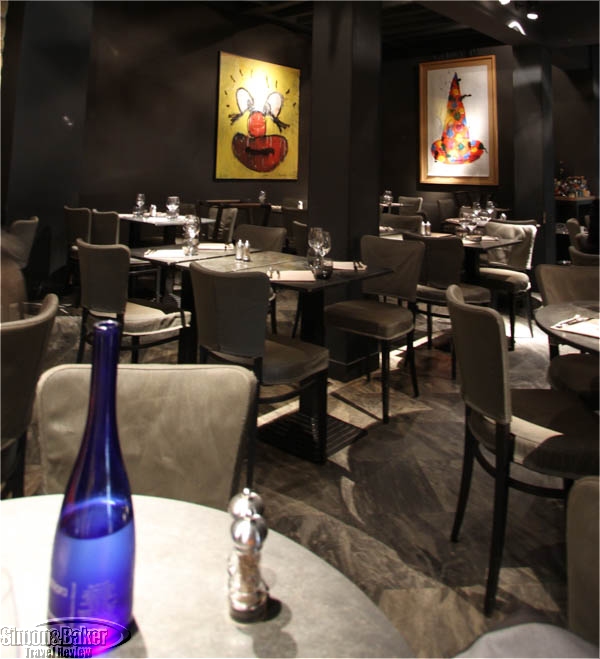
Paintings from the old Guy Savoy restaurant hung at Atelier Marie Albert
It took a few moments for our eyes to adjust from the bright midday exterior sunlight to the low ambient light indoors. The first decorative features we noticed were the familiar colorful clown themed paintings hanging on the back wall. Previous to that day we had last seen them at the Guy Savoy main restaurant. Since the restaurant had moved nearby and been redecorated the paintings had been transferred to their new home. Other salient decorative features were sleet gray marble tile, exposed beams, stone walls and track lights. It was pleasantly serene without being too quiet.

Artichoke soup and brioche from the Guy Savoy bakery
With our friendly English speaking waiter’s help we made our selections from the menu including a glass of wine to match our choices. We both had the Velouté de l’Atelier “en verseurse,” a light artichoke soup brought to the table in a pitcher and served with brioche. It reminded me of a similar soup I had tasted at the chef’s gourmet restaurant. For mains, my lunch partner had the Volaille fermiére du Maine (a quarter chicken portion) for one, a free range spit-roasted fowl dish with a side of mashed potatoes. He ordered a light white from the Pays d’Oc on our server’s advice.
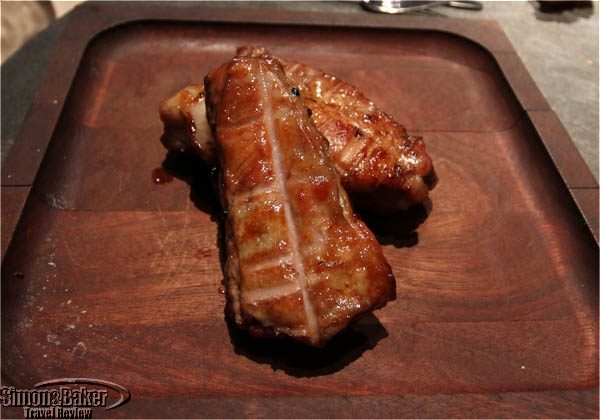
Special ribs still on the bone
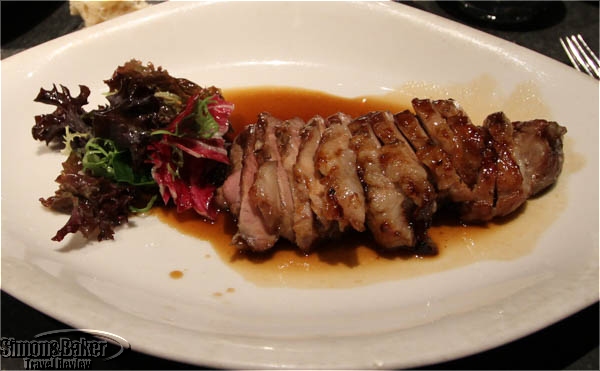
At my request the chef served the pork ribs deboned and sliced
I had Travers de porc “marinés,” marinated pork ribs and a side of Gratin d’épinards champignons (mushroom and spinach gratin). The gratin was a favorite. Both mains were moist and tender with a broth like flavorful sauce. At my request, the kitchen staff had removed the bone from my ribs so they were ready to eat when they were served, although the server was kind enough to show us the ribs before they were deboned. I had a red from Bordeaux. For dessert, I had the Choco pralin-feuilleté, anglais-chicoré, two slabs of dark chocolate and crispy praline with a small dark chocolate ice cream ball.
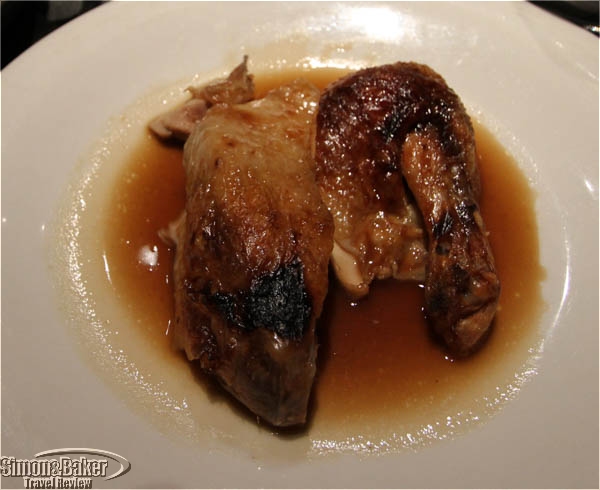
The chicken was served with a broth like sauce
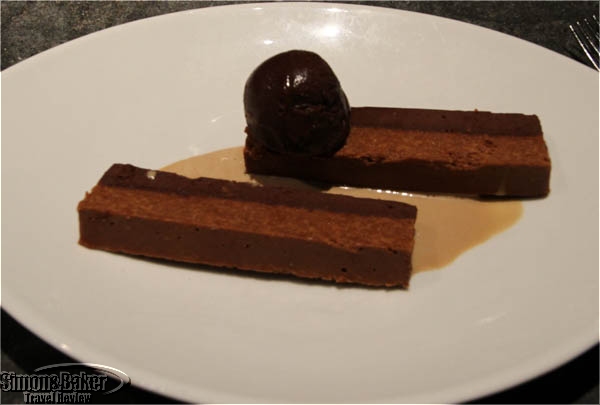
The chocolate dessert
Overall, our comfort food style lunch experience was outstanding. Kudos to Guy Savoy and his collaborators Emmanuel Monsailler, chef, and Laurent Jacquet, manager and their staff. From the soup and salami amouse bouche to the dessert we enjoyed all our courses. The dishes were perfectly prepared and worth repeating. The service was attentive, helpful and friendly. As a bonus, the restaurant was in a central location and convenient to visitors and residents within and near the Latin Quarter. What more could we ask from a neighborhood restaurant?
























